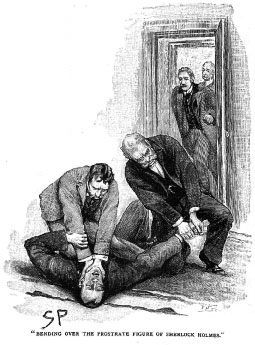 |
|
"The Adventure of Reigate Squire" |
Notes l Bibliography l Download Issue 4 
"The Reigate Squire" (1)
This 1894 story only bore the present title for its first appearance in The Strand Magazine. When it was collected into book form, it was called "The Reigate Squires," the name under which it is most often known. In the U.S.-published Harper's Magazine , it was called "The Reigate Puzzle."
Reigate is an actual town in Surrey lying at the foot of the North Downs (a long line of chalk hills), about 30 miles due south of London. Its history dates back to the time of William the Conqueror.
It was some time before the health of my friend, Mr. Sherlock Holmes, recovered from the strain caused by his immense exertions in the spring of '87. (1)
Holmes's health is always a source of concern to Dr. Watson. Whether he is using a seven-percent solution of cocaine for dubious recreational purposes, forgetting to eat for days on end, or overworking himself to the point of inanition, Holmes chronically neglects his own physical well-being. In "The Devil's Foot" (issue 10) and "The Dying Detective" (issue 11), Watson will again have to deal with the consequences of Holmes's negligent lifestyle.
The whole question of the Netherland-Sumatra Company and of the colossal schemes of Baron Maupertuis are too recent in the minds of the public.... (1)
Once again, Watson mentions a case that was never written.
...that I received a telegram from Lyons, which informed me that Holmes was lying ill in the Hotel Dulong. (1)
If there ever was a Hotel Dulong in the French city of Lyons (a city at the western edge of the Alps in southeastern France), there is no trace of it today.
My old friend Colonel Hayter, who had come under my professional care in Afghanistan, had now taken a house near Reigate, in Surrey.... (1 )
As we learn in the very first Sherlock Holmes novel, A Study in Scarlet (1887), Watson served briefly in the British Army as a military surgeon in Afghanistan before he was "struck on the shoulder by a Jezail bullet" and saved by his orderly (in a few stories, Conan Doyle mistakenly has Watson say that he was wounded in the leg). After recuperating, he suffered a bout of "enteric fever" (typhoid), which resulted in his discharge from the service. Soon after, a friend introduced him to a potential roommate, Sherlock Holmes. Holmes greeted Watson with the now-famous words, "You have been in Afghanistan, I perceive." A little diplomacy was needed, but when Holmes understood that the establishment was a bachelor one.... (1)
Holmes occasionally displays remarkable sympathy for women, but his usual attitude towards them is decidedly misogynistic. In the 1891 "A Case of Identity," Holmes decides not to reveal the true identity of her missing fiancé to his female client, telling Watson, "There is danger to him who snatches a delusion from a woman." Irene Adler, who outwitted Holmes in "A Scandal in Bohemia" (1891), is one of the few women for whose mental powers Holmes harbors respect.
Holmes waved away the compliment, though his smile showed that it had pleased him. (1)
Holmes's modesty is limited. He often calculates his revelation of a solution to have a highly dramatic effect, as in "Silver Blaze," and takes a dim view of those who demonstrate insufficient appreciation for his powers.
"...an odd volume of Pope's 'Homer'...." (1)
English poet Alexander Pope (1688-1744) was considered the greatest English poet during the Enlightenment, but is not widely read today. He translated Homer's Iliad and Odyssey into verse over the course of many years. It would be common for a middle- or upper-class Victorian household to own a multivolume set of Pope's translation, and absurd for a thief to abscond with only one volume.
"The J.P. or his son?" (2)
In the 19th century, a justice of the peace—"J.P.," for short—was a local authority representing the Crown who dispensed judgment to those who had broken local ordinances. The office was not remunerated, and so was usually held by a local magnate.
"...and not to crack two cribs in the same district...." (2)
Conan Doyle loves criminal slang, and peppers his stories with it whenever the occasion arises. Francis Grose's 1811 Dictionary of the Vulgar Tongue defines "to crack a crib" as "to break open a house."
"I have usually found that there was method in his madness." (4)
Watson paraphrases the character Polonius from Shakespeare's Hamlet, Act II, Scene ii: "Though this be madness, yet there is method / in't."
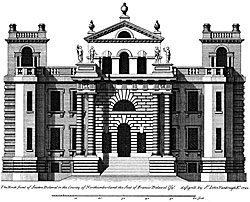 |
|
Seaton Delaval Hall in Northumberland, England, built in 1718-29 by Sir John Vanbrugh, is an example of the English Baroque style. Engraving from Colen Campbell, Vitruvius Britannicus, vol. 3, 1725 |
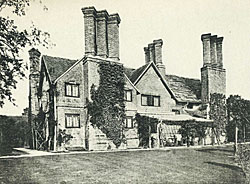 |
| How fine was the Reigate Squires' "fine old house"? An old house in Ockley, Surrey,
is not a baroque mansion, but is rather grand for a farmhouse. |
 |
| East End Farm in Seale is too disordered and homey to be the Squires' home. |
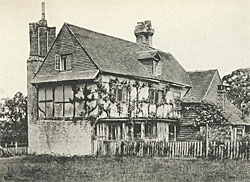 |
| Summersbury Farmhouse in Ewhurst has seen better days, but is still a fine cottage, perhaps not unlike the lodge where William Kirwan and his mother lived. From W. Curtis Green, Old Cottages and Farmhouses in Surrey (London: B.T. Batsford, 1908) |
"...and walked up an oak-lined avenue to the fine old Queen Anne house, which bears the date of Malplaquet upon the lintel of the door. (5)
The ornate, delicate Queen Anne style developed during the reign of the eponymous queen (1702 to 1714). It was, however, primarily a style of furniture rather than an architectural style, making Conan Doyle's epithet, "the fine old Queen Anne House," puzzling. A style of brick house that developed in the 1870s is called the "Queen Anne" style, but since Conan Doyle mentions "the date of Malplaquet" (1709, the date of the Battle of Malplaquet during the War of the Spanish Succession), he must mean that the house is built in the English baroque style, which was current in 1709. This relatively short-lived style was popular for about 60 years, encompassing the reign of Queen Anne, and was influenced by the classical style of Italian architect Andrea Palladio (1508-1580).
"Shall I send you home in my trap?" asked old Cunningham. (5) A "trap" also known as a "dog-cart," was a small, versatile carriage that could carry up to four people, or could be rearranged to carry luggage or cart dogs to a hunting party.
A stone-flagged passage, with the kitchens branching away from it, led by a wooden staircase directly to the first floor of the house. It came out upon the landing opposite to a second more ornamental stair which led up from the front hall. (7)
English houses generally had two staircases: an ornate front staircase for the family and guests, and a "back" staircase for the use of the servants.
"You must try round and get on a fresh scent, I fancy," said the son, with a rather malicious smile. (7)
Holmes's reaction at being compared to a hunting dog is not recorded.
The son, on the other hand, had dropped all that jaunty, dashing style which had characterized him, and the ferocity of a dangerous wild beast gleamed in his dark eyes and distorted his handsome features. (8)
Again, Conan Doyle characterizes a criminal as a throwback to our animal ancestors. The son's earlier characterization of Holmes as a hunting dog now seems ironic.
"Keep that," said Holmes, quickly putting his foot upon it. "You will find it useful at the trial." (8)
Neither fingerprinting nor ballistics was much advanced in Holmes's day. The gun might be useful for determining if the bullet could have been fired from it—or from any gun of that type—but a certain identification of it as the murder weapon was beyond scientists of the time.
"I am afraid, my dear Colonel, that you must regret the hour that you took in such a stormy petrel as I am." (9)
The storm-petrel is a small, migratory, pelagic seabird (it only comes on shore to nest). There are many different species, but the most common types on the
English
coast are the European Storm Petrel and Leach's Petrel. The bird probably received the description "stormy" because it is sometimes pushed onto land by storms at sea. See "The Royal Society for the Preservation of Birds" website at http://www.rspb.org.uk.
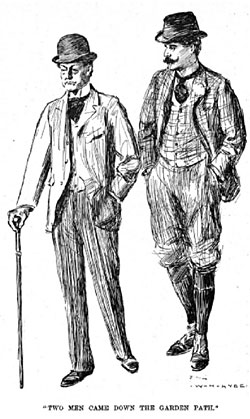 |
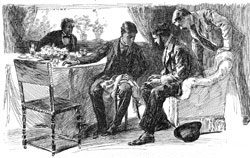 |
| Two pictures from the Harper's Weekly edition of "The Reigate Puzzle," illustrated by W.H. Hyde (June 17, 1893) |
"When I draw your attention to the strong t's of 'at' and 'to' and ask you to compare them with the weak ones of 'quarter' and 'twelve,' you will instantly recognise the fact." [...] "You may not be aware that the deduction of a man's age from his writing is one which has been brought to considerable accuracy by experts." [...] "They belong to men who are blood-relatives. It may be most obvious to you in the Greek e's...." (10)
The science of handwriting analysis was in its infancy in Conan Doyle's time, and was being explored much more in France and the United States than in England. Extravagant claims were made for the efficacy of graphology to determine personality type, sex, age, intelligence, state of mind, and degree of mental health. The art of recognizing the handwriting of someone who was attempting to disguise it does have a basis in science, and is often used in criminal cases today, but reading personality traits from handwriting is a pseudo-science akin to phrenology. Holmes draws conclusions from handwriting in many of the stories.
"In spite of popular belief, even a highly-trained forensic document examiner cannot reliably tell handedness, gender, or age from handwriting. The additional claim, largely made by graphologists, that psychological traits can be deciphered from handwriting has no basis in empirical evidence." From E.J. Wagner. The Science of Sherlock Holmes: from Baskerville Hall to the Valley of Fear, the Real Forensics behind the Great Detective's Greatest Cases (Hoboken, N.J.: John Wiley & Sons, 2006) 166-7.
"The wound upon the dead man was, as I was able to determine with absolute confidence, fired from a revolver at the distance of something over four yards. There was no powder-blackening on the clothes." (10)
For Conan Doyle's day, this is cutting-edge science.
"Of course, we do not yet know what the relations may have been between Alec Cunningham, William Kirwan, and Annie Morrison." (12)
Bringing in Annie Morrison at the end of the story and then not resolving who she is or what part she played in the mystery is a puzzling move on Conan Doyle's part. Are we meant to think that she plays some part in the lawsuit, about which we are told very little, or that Alec Cunningham's desperation and violence can be explained by jealousy? Without Annie Morrison, all the loose ends are neatly tied up. With her, it seems that Holmes might have more work to do before the mystery is truly solved.
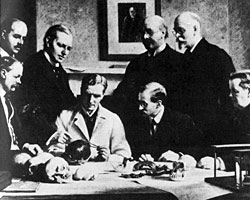 |
|
A portrait painted by John Cooke in 1915 celebrates some of the scientists who supported the veracity of the Piltdown fossils (spread on the table). Standing at right are Charles Dawson and Sir Arthur Smith Woodward. From the Wikipedia Commons |
Why did the scientific establishment take so long to question the Piltdown find? Probably because it was skillfully crafted to meet the desires of contemporary scientists. British scientists desperately wanted to prove that England, not the continent, was the birthplace of mankind (neither is, as we know now). The large cranial capacity of the skull flattered Britain’s nationalistic pride. Let the Europeans have their Neanderthals, with their jutting brows and enormous jaws; primitive British man was a thinker. In reality, the fragmented skull came from a medieval grave, the jaw from an orangutan, and the single canine from an ape. The bones were fractured and dyed, the teeth filed down.
Conan Doyle is suspected not only because of his free access to the discovery site, but because of his ardent spiritualism. Perhaps the ridicule he suffered at the hands of the scientific community for claiming that mediums could really contact the dead in séances made him seek revenge. In his 1912 novel, The Lost World, he says, “If you know your business, a bone can be as easily faked as a photograph.” But, despite his medical knowledge, did he know how to fake fossil bones convincingly? Even if he did, would he have played such a cruel joke on generations of scientists? Men spent their whole careers building theories on Piltdown. The hoax derailed evolutionary understanding of human ancestry for at least 40 years. Wouldn’t an honorable man like Conan Doyle have confessed?
Luckily for our hero, there are plenty of other suspects. Take a look at some of the arguments, and decide for yourself.
See a transcript of the 2005 PBS Nova episode.
For a lineup of suspects, with arguments by the defense and the prosecution, see “The Piltdown Plot” by Charles Blinderman and David Joyce.
|









